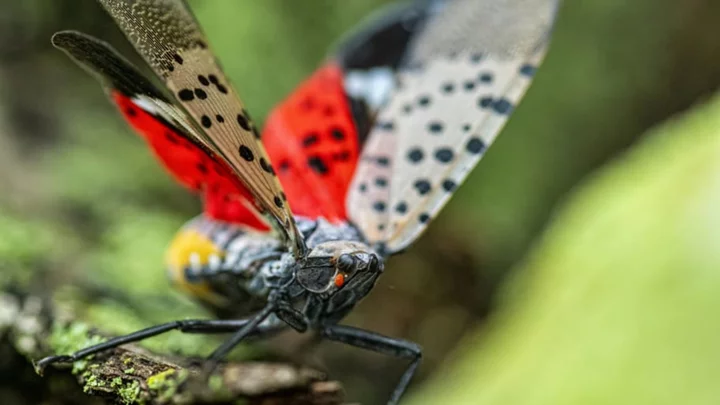You’ve probably heard about Lycorma delicatula, also known as the spotted lanternfly (or “SLF” for short) already: The colorful planthopper—which is related to cicadas—is native to China and other parts of Asia; over the past decade or so, it has crossed hemispheres and become one of the most notorious invasive species in the United States. SLFs have a diet that puts farms and wineries at risk, threatening industries worth hundreds of millions of dollars. Here are a few things everyone should know about these beautiful—but pesky—bugs.
1. Imported rocks may have helped the spotted lanternfly get a foothold in America.
As far as we know, Berks County, Pennsylvania, is where the SLF made its U.S. debut: The first American infestation was reported there in 2014. Environmental officials think those insects likely hatched from eggs that came over in a shipment of stones from China two years earlier. Unfortunately, they didn’t stay put.
2. Counties in over a dozen states are now infested.
The New York State Integrated Pest Management Program (NYSIPM) maintains an interactive map chronicling the spread of spotted lanternflies. According to their data, by June 2023, SLFs had infested parts of Pennsylvania, New York, New Jersey, Connecticut, Rhode Island, Massachusetts, Maryland, Delaware, Virginia, North Carolina, Ohio, Indiana, Michigan, and Iowa. Sightings have also been reported in Vermont and New Hampshire.
3. Adult spotted lanternflies have pinkish-tan wings with black spots.
Lycorma delicatula goes through many life stages. Adult females will lay a mass (or two) of up to 60 eggs from September through November and cover them with a goo that turns gray or tan and acts as camouflage. Next, by the end of May or June, tiny instar nymphs—which are black with white spots and measure around a quarter-inch long—hatch.
The first instar nymphs will slowly triple in length and turn bright red (the bug’s fourth instar), which can occur anywhere from July to September. After that, they become inch-long adults with black-spotted pinkish-tan wings and hindwings that contain shades of red, black, and white.
4. Grapevines are especially vulnerable to spotted lanternflies.
According to the New York State Department of Environmental Conservation, both nymph and adult spotted lanternflies feed on more than 70 plant species using their “sucking mouthparts … This feeding by sometimes thousands of SLF stresses plants, making them vulnerable to disease and attacks from other insects.”
Spotted lanternflies are considered highly dangerous to grapevines. Commercial growers in Pennsylvania have been known to lose as much as 90 percent of their grape yields to the bugs, which may kill or injure vines. Wineries across the northeastern U.S. have grown understandably concerned, and some experts fear the worst if the lanternflies ever make their way to California with its world-famous $170.5 billion wine industry. Other American crops from apples to walnuts may be at risk as well.
5. Lanternfly waste Is another problem.
“Honeydew” is the name given to the liquid excrement spotted lanternflies (and other insects) release after feeding. It’s quite sticky and loaded with sugar, so much so that bees have started making honey out of it at certain times of the year when nectar is hard to come by. (Erik Diemer, co-owner of Pocono Apiaries—which has been bottling and selling that honey—told Lehigh Valley Live that “I can’t just bottle lanternfly honey and sell it as regular honey because people will think this tastes like it has been set on fire.”) That’s nature’s version of making lemonade out of lemons, but the honeydew has its downsides: It promotes crop-damaging mold growths and attracts lots of stinging insects, like those bees.
6. Spotted lanternflies neither sting nor bite humans.
There’s also no evidence to suggest that SLFs are toxic to people or household pets. Dog and cat owners may still want to proceed with caution, however; the bugs have tough exoskeletons that might cause digestion problems if your four-legged buddy swallows one.
7. They can hitch a ride to new territory on cars and other belongings.
Spotted lanternfly egg masses are often found on rocks or tree limbs, but as Penn State entomologist Julie Urban explained in a 2022 WNYC Radio interview, “They're unusual in laying their eggs on essentially anything, not only on what their offspring can feed on but even on human-made structures.” That includes kiddie pools, hunks of rusted metal, firewood piles—and cars. That means unsuspecting drivers can help the SLF invade new territories. “If you’ve spent any time in an area infested with spotted lanternfly it is important to check for egg masses, adults, and nymphs on your vehicle,” notes a brochure released by Cornell University and the NYSIPM. Anyone visiting those places should also double-check whatever belongings they may be carrying around, such as camping gear, outdoor tools, and building materials.
8. There’s more than one way to kill a spotted lanternfly.
SLFs don’t cause much trouble in their native range because natural predators keep the population under control there. That’s not the case in North America, so it’s up to humans to fight the infestation. Eggs can be destroyed by squashing them with a plastic card (or some other hard object) and/or scraping them into a bag with alcohol or hand sanitizer.
For adult spotted lanternflies, insecticides may be an option, although it’s never a bad idea to consult a certified applicator. There’s also the old-fashioned tactic of stomping on the bugs. Some communities have even made a game out of it: On August 28, 2021, around 80 people gathered in Bordentown, New Jersey, for what was gleefully called a “Lanternfly Murder Pub Crawl.” Participants hit up a series of local bars on a warm afternoon—and as they walked, they squashed somewhere in the ballpark of 6000 SLFs. Awards were given to attendees with the highest kill counts.
If stomping on bugs makes you squeamish, you can also trap spotted lanternflies in a water bottle. As Smithsonian explains, “whenever the bugs are trapped or in danger, their first instinct is to leap away. … You can take advantage of this leaping instinct by simply holding an empty water bottle over the insects. The spotted lanternflies will launch themselves straight into the bottle, allowing you to easily collect them. (Remember to put the cap on in between captures so they don't escape.) Once you have a bottle full of invasive pests, you can just put the bottle inside your freezer to humanely kill the insects.”
9. Spotted lanternflies don’t fare well indoors.
Homeowners shouldn’t worry too much about spotted lanternflies getting into their houses: Research shows they can’t survive longer than about 48 hours at room temperature. As with stinkbugs, squishing them indoors isn’t the best idea;, the honeydew from smushed-up lanternflies can ruin fabrics or attract stinging insects. According to S.I. Live, “it’s better to just let your summer visitors be … Then sweep them up in a day or so.”
10. There are some native lookalikes.
It might be tempting to step on any SLF-like insect you see, but before you do, consult a trusted field guide: There are some native look-alikes that are easy to mistake for invasive lanternflies, such as the figured tiger moth or the large milkweed bug [PDF].
This article was originally published on www.mentalfloss.com as 10 Facts About the Spotted Lanternfly.









